Few American airmen have had the kind of dazzling talent and charisma possessed by Robin Olds. His persona loomed equally large whether from the cockpit, the lectern, or in face-to-face encounters.
Olds was big, tough, smart, and swaggering, not to mention brave and highly skilled. Even Hollywood would have had a hard time portraying the genuine article on the big screen. He was a truly dynamic force, one who had a positive impact on the Air Force for more than 60 years.
“His influence upon who we are as an Air Force today can hardly be overstated,” Gen. T. Michael Moseley, Chief of Staff, remarked on the death of the retired brigadier general last June. Olds was “a staunch advocate for better fighters, better pilot training,” and the innovative tactics that the Air Force still uses today, Moseley said.
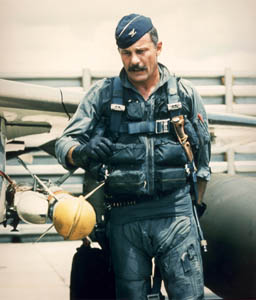 |
Col. Robin Olds in Southeast Asia, circa 1967. |
Olds’ effect on USAF varied both in content and in timing. His career can easily be divided into two eras. In general terms, the first era, which ran from West Point to his retirement, was a period in which his effect was chiefly localized. He was achieving notable combat successes, influencing his peers and subordinates, and often antagonizing his superiors.
In the second, postretirement era his effect spread, and Olds became almost universally embraced, even by those who previously had taken exception to his views.
Olds had great stories to tell, and he polished them over the years, weaving them into his presentations with the wit and the timing of a professional actor. He didn’t mind exaggerating the humorous aspects in some of his stories, but he never exaggerated what he accomplished.
On the Field
His many devoted fans have further embroidered Olds’ stories, with the result that some have become inconsistent over time. One thing is constant: This man was a warrior who led from the front, who cared for his troops, and who never hesitated to say exactly what he thought.
Born on July 14, 1922 in Honolulu, Olds was the son of Robert Olds, a fighter pilot in World War I and later an aide to Billy Mitchell. Eloise, Olds’ mother, died when he was four, and he was brought up by his father, who gave him his first flight at the age of eight, in an open-cockpit biplane. In his later years, Robin Olds would speak with admiration of the great leaders—Ira C. Eaker, Carl A. Spaatz, and others—who met often at his home, as his father eventually rose to the rank of major general.
Robin began to gain prominence while a cadet at West Point, where he played tackle on both offense and defense and was named an All American. (Olds was so proficient on the football field that he was inducted into the College Football Hall of Fame in 1985.)
In later years, Olds told of being deliberately struck by an opponent’s forearm in a game against archrival Navy. The blow knocked out two upper front teeth and sidelined him for a few plays as his bleeding mouth was packed with cotton. Back in the game, he smashed into the man who had hit him, knocking his opponent flat on his back. Olds stood over him, grinning, pointing to his bleeding mouth and then down to the fallen foe.
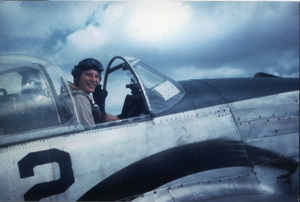 |
Olds (pictured here in 1944) flew with the 479th Fighter Group in Europe during World War II. He was given command of a squadron at the age of 22 |
He graduated from West Point in 1943—the year of his father’s early death—and months later graduated from pilot training, with his wings being pinned on by Gen. Henry H. “Hap” Arnold himself.
Young Lieutenant Olds was well- trained, with more than 650 hours in aircraft, including the Lockheed P-38 Lightning, when he entered World War II combat. He flew with the abandon of a man who knows he is invulnerable and for whom the enemy is only a target.
Olds began his sensational rise as a fighter pilot in Europe, where he flew 107 missions, scored 12 aerial victories, and destroyed another 11-and-one-half enemy aircraft on the ground. His knowledge of air combat grew with his victories and so did his willingness to speak out about his beliefs—no matter how contrary they were to current doctrine. It was a trait that would work more often against him than for him.
From P-51s to P-80s
At the peak of the air war against Germany, Olds saw how heavy bombers’ precision attacks were being converted into area bombing by wind, weather, and enemy opposition.
He put forth the idea that 70 P-51s armed with 500-pound bombs could do more damage to a target requiring precise accuracy than a formation of 1,000 B-17s.
As an idea, it was 20 years ahead of its time—and it ran directly contrary to USAAF philosophy. It was the first of many of Olds’ ideas whose time had not yet come, a condition that would frustrate him over the years, and helped induce in him flamboyant behavior that worked against both his acceptance and his advancement.
The refusal to accept his idea about precision bombing was puzzling to him because he was awarded many decorations. Most satisfying of all, he was given command of his squadron as a 22-year-old major. In later life, he sometimes remarked on the strange “disconnect” between the increase of his responsibility on one hand, and the rejection of his ideas on the other.
After the war, Olds was placed in the very first Lockheed P-80 jet aircraft squadron. This was a desirable assignment, as well as a dangerous one, for the loss rate in the early jet aircraft was high. He also flew with the Aerial Aerobatic Demonstration Team, the forerunner of the Thunderbirds, the first American jet aircraft aerobatic team. For good measure, he also placed second in the jet aircraft division of the 1946 Thompson Trophy Race.
He added to his high visibility level by marrying movie star Ella Raines. He and Raines separated in 1975, but remained married until her death in 1988.
Also of note was his assignment to an exchange program with the Royal Air Force where he flew the Gloster Meteor jet fighter and then served in the prestigious position of commander of No. 1 Squadron, RAF.
However, when the Korean War came, Olds was unable, despite considerable effort, to get back into combat. In private conversations, he would attribute this directly to one of his superiors who told him in essence, “If I cannot get there to fight, you are certainly not going to get there.”
After Korea, Olds became deeply discontented with the direction he saw being taken by tactical airpower: Tactical Air Command became increasingly focused on the nuclear mission.
Olds continued to distinguish himself by brilliant flying and the ability to ruffle his superior’s feathers. At a time when TAC was oriented to the delivery of nuclear weapons, Olds, through a series of papers, continually called for intensive training in air-to-air combat, close air support, and development of new tactics. He also sought better pilot training, better fighters, and surgical precision in bombing, just as he had done during World War II.
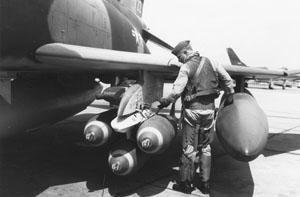 |
Olds runs a munitions check on his F-4 before a mission during the Vietnam War. He was stationed at Ubon AB, Thailand. |
Something Missing
Olds became dissatisfied with his career, despite assignments that most fighter pilots would have coveted. These included the command of a wing in Europe, the 81st Tactical Fighter Wing at RAF Bentwaters, England, where Col. Daniel “Chappie” James Jr. was his deputy commander for operations.
The two men would team up again later, becoming famous as “Blackman and Robin” in the Vietnam War. In between these assignments, Olds worked at the Pentagon and graduated from the National War College. His promotions came in good order, yet despite his satisfaction in leading first-class flying units—and despite the admiration in which he was held by his officers and enlisted men—there was something missing. Olds wanted the acknowledgement that he was a thinker as well as a doer.
Unfortunately, his ideas on a return to training geared to fighting a conventional air war were rebuffed.
His desire to remain in an active flying job was more important to him than his imminent promotion to brigadier general. As commander of the 81st, flying McDonnell F-101 Voodoo fighter-bombers, Olds formed an aerial demonstration team and performed an unauthorized low-level aerobatic display.
His boss reprimanded him, and as punishment, ripped up Olds’ promotion papers. His next assignment was to Shaw AFB, S.C., where it seemed his career had reached a dead end.
In fact the opposite was true: He had crafted a situation where he could return to combat and achieve his greatest fame.
For the first time since his combat in Europe, time and events were on Olds’ side. The United States was becoming increasingly involved in the Vietnam War and in 1966, Olds was assigned to the 4453rd Combat Crew Training Wing at Davis-Monthan Air Force Base in Arizona. His old friend Chappie James was there, as was then-Maj. William L. Kirk.
There followed the decisive event that would foster Olds’ ascent from simply being a hero to a few and a troublemaker to many. On Sept. 30, 1966, he became commander of the 8th Tactical Fighter Wing, based at Ubon AB, Thailand.
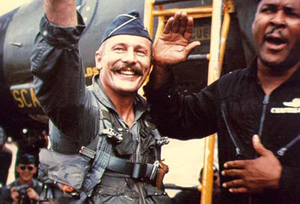 |
Col. Daniel James Jr. (right) served as Olds’ deputy commander for operations at the 81st Tactical Fighter Wing at RAF Bentwaters, England, and teamed up with him again during the Vietnam War. |
The wing needed Olds as badly as he needed the wing. He introduced himself to his largely dispirited and tired pilots in his usual fashion, with a challenge: Olds was going to fly as a new guy until he learned his job—and then he was going to lead the wing into combat from the front.
There was suspicion that this World War II retread was just talking a good game, but Olds soon proved himself to be a master of the F-4 and an inspiring leader.
The stories of his methods are legion. He shook up the base’s support staff, putting it on the same 24-hour clock as his combat crews. He continually visited the support groups, finding out what their problems were in an effort to get them solved. And he was not above tipping a bottle of beer with his airmen as they discussed how to improve operations.
He led his wing as he had promised, from the front, with flair and aggressiveness. Olds ultimately flew 152 missions in Southeast Asia, 105 of them over North Vietnam. He encouraged camaraderie at the bar, grew an unauthorized mustache, and demonstrated at the age of 44 that he was the physical, mental, and flying equal—or superior—of any man in his unit.
Olds had always had good effect on the morale of the units he led. He was gregarious, was always concerned about the welfare of his people, and like many of his contemporaries he drank too much for his own good.
His prescient view of the types of training required for air combat was far in advance of most of his superiors. It was ignored for many years because it was contrary to contemporary doctrine—and, in truth, partly because of his flamboyant nature.
Unfortunately, prior to the Vietnam War, he was never able to impose his ideas with the same elegance that he used in leading the 8th TFW.
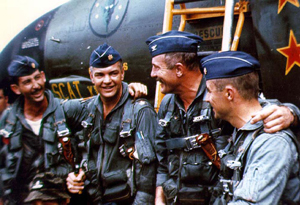 |
Olds is congratulated by members of his wing, including Maj. William Kirk (second from left), after his last flight at Ubon. He flew 105 missions over North Vietnam, and shot down four MiGs. |
First and foremost, Olds wanted to kill MiGs, but the North Vietnamese were canny. Few in number, they husbanded their resources, striking against Republic F-105 formations when they could do so safely. The North Vietnamese were content, if necessary, with a preservationist strategy of just making the Thunderchiefs drop their bombs before they reached the target area.
It was deeply satisfying for Olds to see over Vietnam that all the ideas that he had advocated—better airplanes, more training in air-to-air combat, bombing, and close air support—had been correct all along. For Robin Olds, it was vindication.
Impatient with the reluctant enemy, Olds conceived a plan that became the single most important air-to-air engagement of the war, and which started him into the second era of his career—the period in which he had immense effect on virtually everyone in the Air Force.
Calling on the skill and guile of the leading members of his wing, Olds created Operation Bolo. The plan was elegantly simple: Modern F-4s would imitate the call signs, routes, and flight profiles of more-vulnerable F-105s in a bid to coax North Vietnamese fighters into a trap. The tactics worked and induced the North Vietnamese Air Force to believe that a Phantom formation was indeed a formation of Thunderchiefs.
In the ensuing battle, seven MiG-21s were shot down, the biggest score of the war.
Olds shot down the first of his four MiGs in this battle, raising his total number of victories to 13 on the way to a career total of 16.
A Promotion Long Overdue
After his stint in the war, his Air Force career was distinguished by the popularity he enjoyed as a strict but caring commandant of cadets at the Air Force Academy. He finally became a brigadier general in 1968 (a promotion long overdue in the minds of many), but subsequently was assigned to positions that did not lend themselves to more promotions.
Yet promotions were the furthest thing from Olds’ mind. Asked by Air Force Chief of Staff Gen. John D. Ryan in 1972 to investigate why the Air Force kill ratio had plummeted late in the Vietnam War, Olds came back with a blistering report that impugned USAF’s contemporary training. He offered to accept a reduction in rank to colonel so that he could go back and personally inculcate the necessary fighting techniques, but this proposal was refused. Olds elected to retire in 1973.
By this time, Olds’ influence was already growing. He continued to put forth his ideas, addressing countless groups around the country, often beginning his talks with four words that truly characterized him.
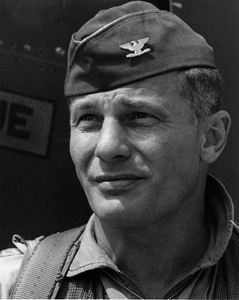 |
Olds recorded the first of his Vietnam War kills during Operation Bolo in January 1967. His victory made him the first and only USAF ace with victories in both World War II and Vietnam. He finished with a grand total of 16 kills. |
Olds would stand before the group—sometimes military people, sometimes a Rotary Club, it didn’t matter. He would square his shoulders, wait for a few tension-filled seconds, then shout, “I AM A WARRIOR.” No one ever doubted him.
Though he never seemed to seek it out, his popularity continually increased.
Olds continued to write influential papers on his ideas about aerial warfare. It is the mark of the man that when technology at last reached a point where his ideas on training and tactics no longer applied, he welcomed the change.
Olds realized that the advent of stealth, precision guided weapons, and sophisticated command and control forever changed the dynamics of air combat, and he said so.
He also labored over an autobiography that was not completed by the time of his death, but that would be massively welcomed by his legion of fans.
After a long fight, Robin Olds succumbed to congestive heart failure on June 14, 2007, surrounded by his family and friends. He was interred at the United States Air Force Academy Cemetery with full honors and a unique missing man formation. Four Phantoms roared over, and instead of the customary pull up by the lead’s wingman, in this instance, the lead himself pulled up. It was an appropriate salute to the one, the only, Robin Olds, a leader all his life.
Walter J. Boyne, former director of the National Air and Space Museum in Washington, D.C., is a retired Air Force colonel, author, and member of the National Aviation Hall of Fame. He has written more than 600 articles about aviation topics and 50 books, the most recent of which is Soaring to Glory. His most recent article for Air Force Magazine, “A Study in Stripes,” appeared in the March issue.
